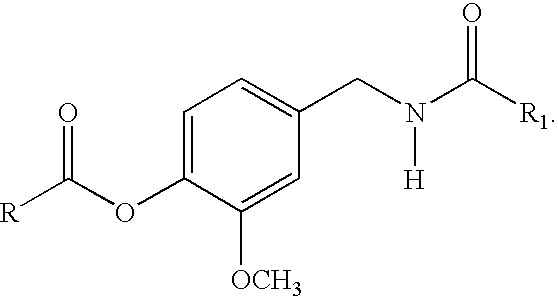Esters of capsaicinoids as dietary supplements
a technology of capsaicin and dietary supplements, which is applied in the field of dietary supplements, can solve the problems of inability to block the inability of glucocorticoids to block the capsaicin-induced flare, and the inability of glucocorticoids to overcome the vasodilator effect of capsaicin, etc., and achieve the effect of reducing virus infection or ameliorating virus infection symptoms
- Summary
- Abstract
- Description
- Claims
- Application Information
AI Technical Summary
Benefits of technology
Problems solved by technology
Method used
Image
Examples
example 1
Preparation of Butyryl Ester of Capsaicin USP (Formula I, R═C3H7)
[0196]A mixture of 30.5 gm (˜0.1M) of capsaicin USP (HUBEI XIANGXI CHEMICAL INDUSTRY CO., LTD, China), 16.7 ml (0.12M) of anhydrous triethylamine (Spectrum Chemicals) and 200 ml of anhydrous dichloromethane was placed into a 1000 ml 2-neck round bottomed flask. The content was covered with aluminum foil to protect it from light exposure. The flask was fitted with a condenser fitted with a moisture trap on the top and a dropwise addition funnel. The flask was kept at room temperature and 12.8 ml (0.12M) of butyryl chloride was added from the funnel into the mixture slowly with stirring. After the addition, the mixture was refluxed for 3-6 hours and stirred for 10-15 hours at room temperature. The mixture was transferred into a separating funnel and washed successively with 2×500 ml of water, 2×500 ml of dilute hydrochloric acid, 2×500 ml of 10% sodium bicarbonate solution and 3×500 ml of type I water. The organic layer ...
example 2
Preparation of Hexanoyl Ester of USP (Formula I, R═CH3—(CH2)4)
[0197]The compound was prepared essentially as described in Example 1, using n-hexanoyl chloride instead of butyryl chloride. The product was recovered as a low melting viscous yellow oil.
example 3
Preparation of Palmitoyl Ester of Capsaicin USP (Formula I, R═CH3—(CH2)14)
[0198]The compound was prepared essentially as described in Example 1, using n-palmitoyl chloride instead of butyryl chloride. The product was recovered as a waxy yellow solid.
PUM
| Property | Measurement | Unit |
|---|---|---|
| wt. % | aaaaa | aaaaa |
| particle size | aaaaa | aaaaa |
| time | aaaaa | aaaaa |
Abstract
Description
Claims
Application Information
 Login to View More
Login to View More - R&D
- Intellectual Property
- Life Sciences
- Materials
- Tech Scout
- Unparalleled Data Quality
- Higher Quality Content
- 60% Fewer Hallucinations
Browse by: Latest US Patents, China's latest patents, Technical Efficacy Thesaurus, Application Domain, Technology Topic, Popular Technical Reports.
© 2025 PatSnap. All rights reserved.Legal|Privacy policy|Modern Slavery Act Transparency Statement|Sitemap|About US| Contact US: help@patsnap.com


